Design at Scale 2021-Scaling Design Beyond Designers (Lona Moore)
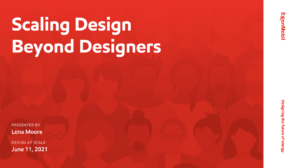
—> Excited to join everyone for the final day of design scale, and I’m glad to have heard the importance of keeping people at the center of our work and driving change across the enterprise
—> I’ll talk about how we embraced mindset to scale design beyond designers at Exxon Mobil
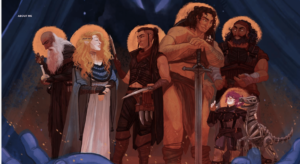
—> I’m a fan of various communities, as friends come from local Dungeons and Dragons board game groups
—> The enterprise world may be different but has its own dragons and problems to solve, including how to shift toward more human-centered culture
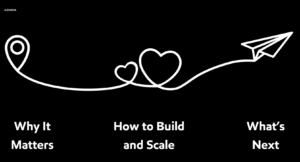
—> So I worked to create an internal design community at Exxon Mobil
—> I’ll tell you why this matters, how Exxon Mobil’s community was built/scaled, and how you can do the same
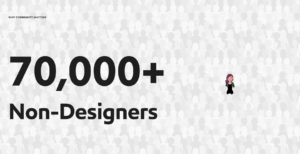
—> Scaling design is hard, and scaling it across established enterprise with established history, and over 70,000 non-designers is even harder
—> But it’s my job to enable non-designers to learn share and practice design together
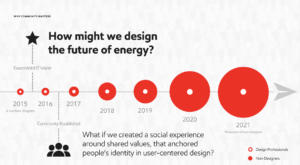
—> Back in 2015, our IT leadership wanted to focus on end-users both internal and external
-
Our design practice was just starting then, I was working at the time as a software engineer at Exxon’s Houston campus
—> We asked: How could we make a difference and design the future of energy?
-
We realized making an impact required Exoon Mobil developers, engineers to apply design thinking to solve wicked problems, activiating their creativity at scale
—> In 2016, we created a User-Centered Design (UCD) 101 class to get non-designers onboard. However, we needed to distinguish design thinking from technical engineering
-
In industries removed form design/tech, we need to clearly distinguish what we mean
-
In terms of design education maturity, we were somewhere between getting recognized and showing design had value
—> We wanted design to thrive and wondered if we created a social experience around shared value that anchored identity in UCD?
—> We focused Exxon Mobil’s design community as the way to drive change. That community now has 1000s of people, mostly non-designers
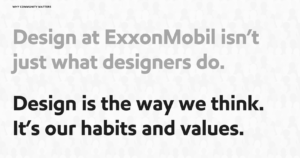
—> Design’s ambition is to change how people think and apply more human-centered way to solve problems
-
It’s a collection of habits and values
—> This might feel less intuitive in traditional companies, but we need our people to increase it
—> As the design community manager, I’m the DJ amplifying the power of design to get people on board
-
Our community is thousands of people, and over 90% are not designers
-
So we encourage as many people as possible to participate
—> If I can spread design thinking at Exxon Mobil, you can too in your company
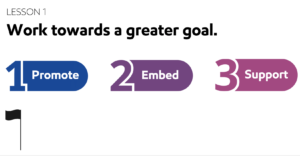
—> Here are some tips I learned to do this
—> First, connect the dots between company’s vision and the people within it
-
Think about what problems are being solved
-
For us it was promoting, embedding and supporting design within the company
—> We set up these goals so that we can look at them on our virtual whiteboard
-
We had fantastic senior leaders and managers who worked hard to quantify value of design, and demonstrated design’s business value for Exxon Mobil
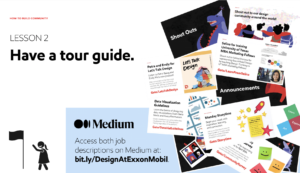
—> Next have tour guides who offer direction to people. In my role, I’m the self-described tour guide
-
My job is to guide people through design process and teach people how to do it
—> As an enablement advisor, I’ve provided design tools, resources to people
-
Job has changed and I pitched my title and responsibilities to my boss, but bringing the tour guide mindset is a key part of my role
—> You can access more detail on Exxon’s Medium page if you want
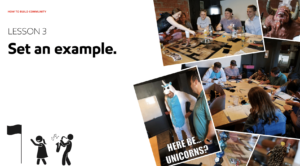
—> Next, set an example. If you want to teach people power of storytelling and yes/and, why not have a role playing game to channel inner unicorns?
—> Setting example for human-centered habits encourages people to embrace the habits of design and building out on people’s design
-
Collaborate with people and cultivate playful environment to create the needed psychological safety and enthusiasm for the work
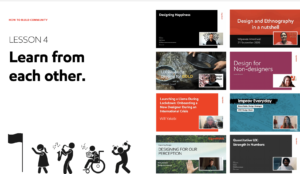
—> Next, make sure to learn from each other
—> Learning is a key for design, and I invite anyone to reach out to me with potential learning opportunities within their community, and work to send their ideas out to the global stage
-
A person doesn’t have to be design professional to do this
—> Some ideas require nurturing, but I work to help bring them to life, inspired others to do the same
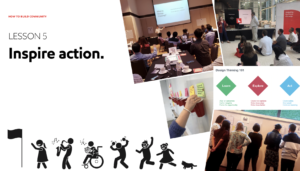
—> Finally, make sure to inspire action!
—> Our people give a community life, as our internal design lead created a Design Thinking 101 classes, framing design as way to solve complex problems, encouraged non-designers to attend
-
Tips on how to do this are on Medium as well
—> Difference matters to our community and happens through design and helped us scale our community, by changing people’s hearts and minds
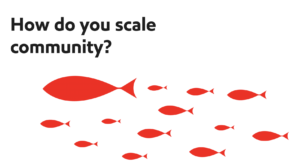
—> Scaling design community takes time though, as it’s a monumental task
-
We are a lot closer to permeating design through the Exxon community
—> Here’s what we learned
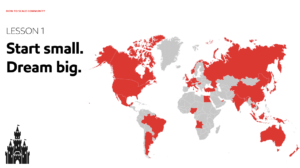
—> First start small, then aim big: We began working towards a greater goal that focused on anchoring people’s identity in design
—> Dreamed big in spreading design beyond it’s initial home in the United States
-
Used UCD 101 to set up communities of practice and encouraged people to practice community members.
-
Set short-term goals to demonstrate progress
—> Our approach helped us reach out to people regardless of expertise, background,
-
People felt safe thinking about design was crucial to success
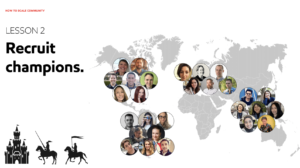
—> Next, we had to recruit champions.
—> We needed many tour guides to scale design beyond designers, so as part of our class rollout we recruited champions and local chapter leads, many of whom were not in design roles
—> Local chapters were then self-sustaining and ranged from few employees to a few thousand and consist of various community leads who own the local chapters
-
They find strategies that people are responsible for executing for
—> These communities nominate their replacements and work together to onboard them
-
Most classes are not even taught in English
—> Global community is open to anyone, what matters is the passion for driving design forward
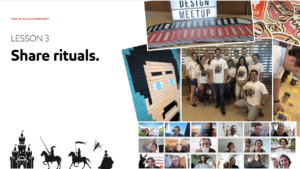
—> In addition to making connection, rituals help scale human-centered habits across org boundraries
-
They symbolize identities and values of the design community
—> Each location may have different rituals, and enable people to learn and share
-
Can dive into rituals used, on our Medium page
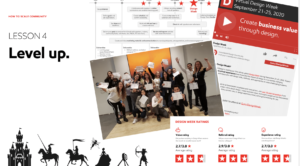
—> Next, opportunities for professional development opens people to new ideas and boosts expertise, and encourage people to learn from industry leaders
—> Updated internal training including an internal design conference, in addition to internal projects
-
New opportunities at this scale may face pushback, and demonstrating business value helps us succeed in quantifying the value of the activity helps get results
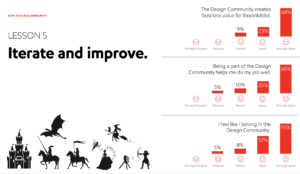
—> Finally, continue to iterate and improve. We worked constantly to change people hearts and minds
-
But we need to still iterate and improve as communities
-
We constantly collect feedback to improve our community and design practice
—> We can see feedback from our latest community survey
-
All questions are listed in the Medium article
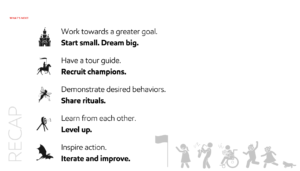
—> So what’s next? Here’s my advice:
-
Works towards greater goal. Dream for long term change, and start with short-terms goals
-
Recruit champions ot scale
-
Share rituals and demonstrates desire behaviors
-
Learn from each other and level up as you scale
-
Inspire action for people to make change through design, and hope I’ve inspired you to do this
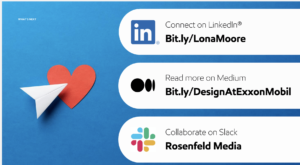
Q&A
- How do you ensure that “playful” brings business value, not just seen as “playful for the sake of playful”?
—> Show how the environment sparks creativity and new ways of thinking
—> Leaders have embraced the work, and more tips are in the Medium articles
2. What are the ongoing activities that you are doing within the Design community?
—> Recurring ones for global community are monthly calls and webinars, internal design conference, starting week with story time and pulling from different needs
—> Showcasing community efforts and how they worked
3. What was your strategy for pitching a job title + responsibilities?
—> The boss was open to new ideas, and used template for pitching an idea
—> I have created principle design roles based off senior folks supporting the needs
—> I pitched change based on how my job responsibilities had evolved, which is why I pitched it
4. Thinking selfishly—how has building a design community affected the Design Team?
—> I’m proud how design teams have embraced the work, and design professionals have leveraged the community to make their work more impactful
-
Allowing scaling of design activities
—> I value design craft as the core of work at Exxon Mobil, but involving other people makes people move faster together

